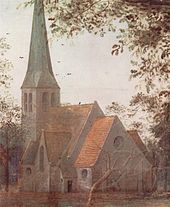Dilbeek | |
|---|---|
 De Viron Castle, serving as town hall | |
| Coordinates: 50°51′N 04°16′E / 50.850°N 4.267°E | |
| Country | |
| Community | Flemish Community |
| Region | Flemish Region |
| Province | Flemish Brabant |
| Arrondissement | Halle-Vilvoorde |
| Government | |
| • Mayor | Willy Segers (N-VA) |
| • Governing party/ies | N-VA, Open Vld |
| Area | |
| • Total | 41.48 km2 (16.02 sq mi) |
| Population (2018-01-01)[1] | |
| • Total | 42,434 |
| • Density | 1,000/km2 (2,600/sq mi) |
| Postal codes | 1700–1703 |
| NIS code | 23016 |
| Area codes | 02 |
| Website | www.dilbeek.be |
Dilbeek (Dutch pronunciation: [ˈdɪlbeːk] ⓘ) is a municipality in the province of Flemish Brabant, in the Flemish region of Belgium. The municipality comprises the villages of Dilbeek proper, Groot-Bijgaarden, Itterbeek (with Sint-Anna-Pede), Schepdaal (with Sint-Gertrudis-Pede), Sint-Martens-Bodegem, and Sint-Ulriks-Kapelle. Dilbeek is located just outside the Brussels-Capital Region, in the Pajottenland, hence the local name Poort van het Pajottenland (Gate to the Pajottenland). Even though Dilbeek is located in the Dutch language area of Belgium, there is a French-speaking minority represented by 3 members on the 35-seat local council.[2] It is a mostly residential community with some preserved rural areas and some industrial zones.






